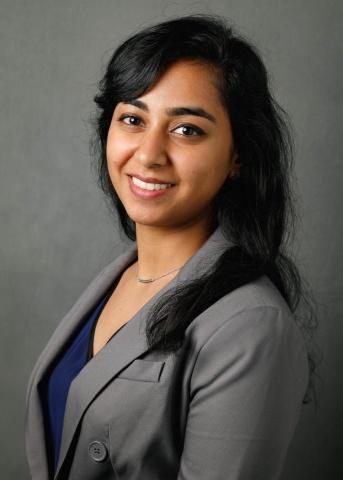
This week’s “spotlight” interview shines on Safa Kaleem, a rising fourth-year medical student at the Duke University School of Medicine, as well as a recent graduate of the School’s Clinical Research Training Program. Kaleem talks to us about her master’s project, where she helped validate quantitative EEG, a tool that offers great promise in improving diagnosis and treatment for patients with nonconvulsive seizures. She also talks about bringing together faculty and students of all brain-related disciplines as president of our Student Interest Group in Neurology (SIGN), her plans to continue with clinical research as a resident, fellow, and beyond, and unwinding with gardening, baking, and rock climbing when she’s not at Duke.
What was the focus of your research year at the Duke University School of Medicine, and how will it help us better understand or treat neurological conditions?
My main research project with Dr. Christa Swisher focused on seizure detection in the Neuro Intensive Care Unit (Neuro ICU) via Neuro ICU nurse interpretation of quantitative EEG (qEEG). A large proportion of Neuro ICU patients suffer from nonconvulsive seizures, which are correlated with worse outcomes, but diagnosis can only be made through review of continuous EEG, which can be time consuming and requires a high level of training and expertise, leading to delays in diagnosis and treatment. Quantitative EEG is a graphical and compressed display of continuous EEG and can be interpreted by non-experts.
Our study trained Neuro ICU nurses on qEEG and had them log seizures at the bedside. We found that nurse interpretation was sensitive, specific, and often faster than traditional EEG review! This may help improve outcomes for our Neuro ICU patients. I also helped with some of the ICU fellows’ studies and some multicenter studies focusing on various clinical questions in the Neuro ICU.
What about this project did you enjoy the most? What part(s) were the most difficult?
I really enjoyed getting to know the wonderful ICU nurses on 8E! They were eager to learn a new skill and patient with me as I took them through training and paperwork. I myself also enjoyed learning a new skill in qEEG interpretation. It was challenging to catch patients being put on EEG on time, and the statistical analysis for the project was daunting, but I learned so much in the process.
How and when did you first become interested in neurology? What about the field interests you the most?
I first became interested in neurology as an undergraduate here at Duke University, where I was a neuroscience major. I was fascinated by the intricate physiology of neurons and neurotransmitters and was enchanted by how those chain reactions give us consciousness, curiosity, and the ability to think about the world around us. I took classes in the cellular and molecular biology of the brain, cognitive neuroscience, as well as in neuroanatomy with Dr. Len White. As a medical student, I found myself looking forward to studying for my neurology basic science exams as well as clinical shelf exams. I could see myself staying curious and fascinated by the brain for years to come!
You recently earned your master’s degree in Health Science in Clinical Research. What was the focus of your master’s project, and how does this experience inform your perspective as a medical student?
The focus of my master’s project, which I completed with Dr. Christa Swisher, was nurse interpretation of qEEG for seizure detection as I explained above. By completing my master’s classes in tandem with conducting that retrospective study, I was able to apply what I learned about study methodology, statistics, and research ethics to my project. I wanted to complete this masters because during my clinical year of medical school, I loved generating questions on rounds and finding research to support various treatments, tests, or diagnoses. Occasionally, we would ask questions which as yet had no answers. I felt inspired to be part of the research community who would help answer those questions and guide evidence-based medicine for future patients. I hope to continue to do clinical research in residency, fellowship, and beyond.
What were some highlights of your year as president of SIGN? Do you plan on continuing to lead the group in the coming year?
This year, I am proud of how many first-year students we were able to engage with our events! My favorite event we plan each year has to be the Neuroscience Research Fair, where we collaborate with the Neurosurgery Interest Group (NSIG) and the Psychiatry Interest Group to bring together Duke faculty and researchers from various departments and showcase all the incredible cutting-edge research being done to interested medical students. And of course, the bi-annual dinners with Dr. O’Brien are a lovely and laid-back way for students to interact with Neurology faculty and be able to see themselves in their shoes. This coming year, I hope to pass on the torch to an underclassman so that they can continue to grow and expand the organization!
What plans do you have for life after graduation? If you could have any job in the world, what would it be?
I will be applying to neurology residency programs this fall! I hope that whatever program I end up going to will help me achieve my goal of becoming a neurologist and clinical researcher so that I can spend my days seeing patients and answering clinical questions on optimal evidence-based management of neurological disease.
What other passions or hobbies do you have outside of Duke?
In my spare time, I like to unwind by gardening, baking, reading, or rock climbing! I recently began indoor rock climbing during my research years and I’m hoping that the gyms open up (safely) soon so that I can get back into it.

Above, Kaleem reps Duke Neuroscience in front of the Wilson Gym climbing wall during her first climbing competition in 2019.